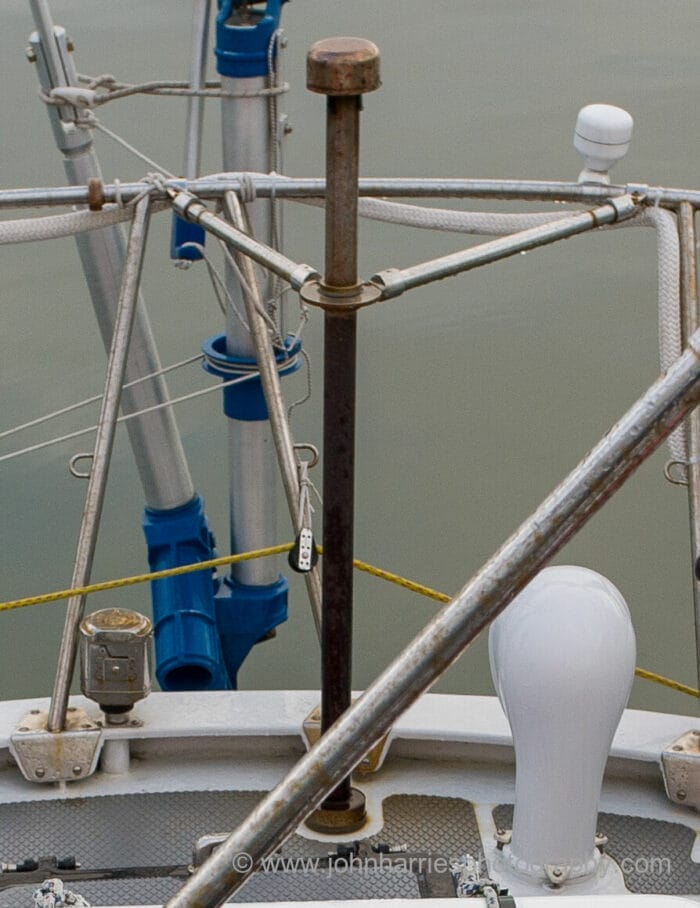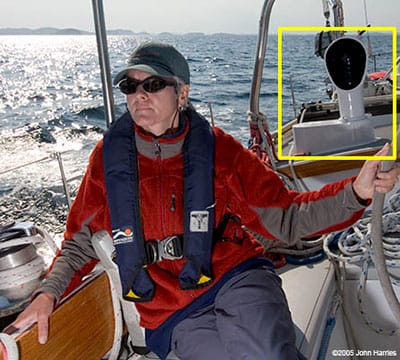
Question: Is keeping the interior of the boat dry in the midst of prolonged damp, chilly weather, and/or sea spray just a matter of dorade vents, hull insulation and your Espar heater? Do you have success keeping the interior dry or does it inevitably get damp?

Answer: If you already have a boat, there are some things you can do to at least help the problem:
- Install an extraction blower over the galley. The stove is one of the biggest moisture generators, particularly since a byproduct of burning propane is water vapor. When we wintered over in Norway we installed a second bilge blower and a vent on the suck side of the blower over the stove and routed the blow side out a dorade. This really helped.
- When installing a heating system you have to decide how much outside air to let into the supply side of the furnace. For example, the Espar on Morgan’s Cloud is installed in the lazarette right under a large dorade vent. If we close the dorade, the heater just re-circulates the air in the boat, which is more efficient than opening the dorade and letting the heater draw cold air in from outside. However, keeping the dorade at least partly open results in a MUCH dryer boat, since we are drawing in dry outside air, heating it—which drops its relative humidity—and forcing moist warm air out through other ventilators. The point being, you have to think about airflow and trade off efficiency against dampness. We found that in Arctic Norway, where we spent two winters, where the air was dry and cold, it was better to keep the dorades pretty much closed, but in London, England it was better to open almost all of them and get rid of the damp. (The winter in London was brutal for dampness, the worst we have ever experienced. In the end we bought a dehumidifier.)
- Our biggest problem on Morgan’s Cloud, like most boats, is condensation forming on the hatches and ports. In Norway we covered both with plastic sheeting separated from the metal by bits of adhesive foam; in effect double glazing—not elegant but it worked like a charm. Update, 2007: During the last refit we designed and had built wooden bezels around each port that accept Plexiglas covers, which will do the same thing and are more elegant.
- Make sure you have a heater that can be run in any weather offshore. I can’t tell you the number of boats we have met, even in the Arctic, that have to cap off the heater at sea because of worries about burning something on the chimney or getting water down it. Don’t let anyone sell you one of those ‘toy’ exhausts for an Espar that pokes out of the hull of the boat. Ours is on the aft deck, massively braced to the rails, and three feet high. The result is that we can run the heater in any weather.

Hello Morgan’s Cloud,
Regarding your heater exhaust, I installed an Espar heater two years ago, also in my lazarette, and I piped my exhaust through the transom, using the same sort of hose you use to exhaust your aux. diesel. This was recommended to me by Espar. The exit ports (for both my diesel and the heater) are covered by small flaps that automatically close out the weather. Just another option.
Thanks for the great site!
Justin R.
S/V Cassiopeia
Thanks, Justin. Sounds like a good option.
Gee, this must be one of the older posts here…
I have a Mermaid Marine Air 12,000 BTU heat pump system. If you have water above 40F, it can extract heat from it. It’s also an A/C, and it works quite well, except in the pilothouse, which can get very warm at dock because I have yet to install shades.
Anyway, the cost of the MMA set-up is amps. Dock power is no problem, but the unit takes 17 amps to kick off the AC-power March pump it requires, and then eats about 6 amps in operation. So I am looking for a liquid fuel solution or at least a back-up. Ideally, I would use the existing ventlines, which run throughout the boat. How this would actually work, I don’t yet know.
Have you ever read “The Warm, Dry Boat” by Roger McAfee. If not self-published, it’s pretty close, but it’s a very useful primer on ventilation and air exchange, which McAfee considers more important for comfort than simply having a fire in a box on board.
https://www.amazon.com/Warm-Dry-Boat-Roger-McAfee/dp/B000MVXQV2